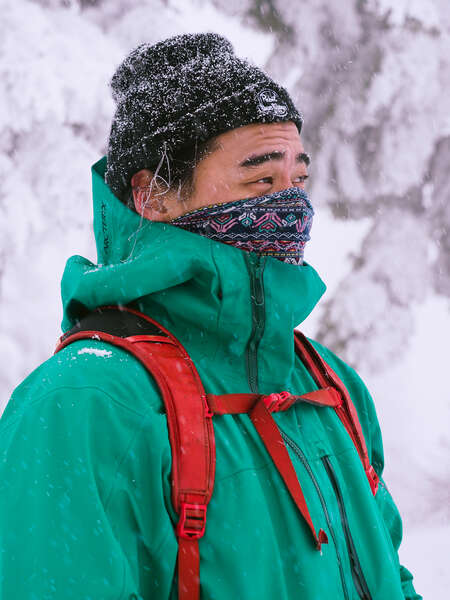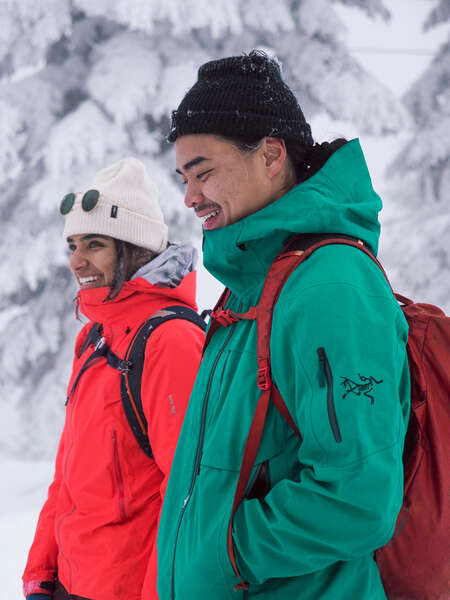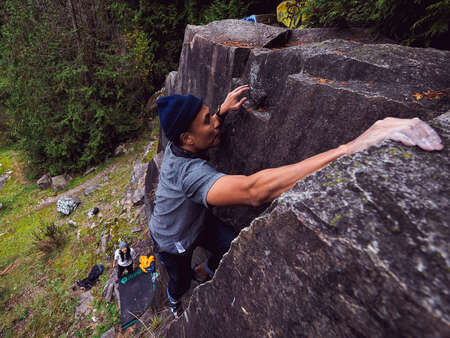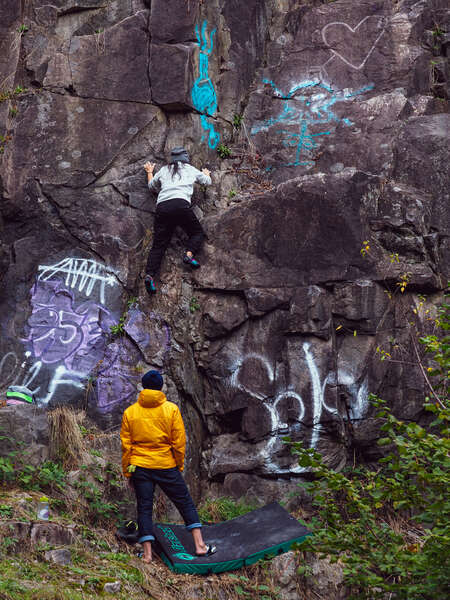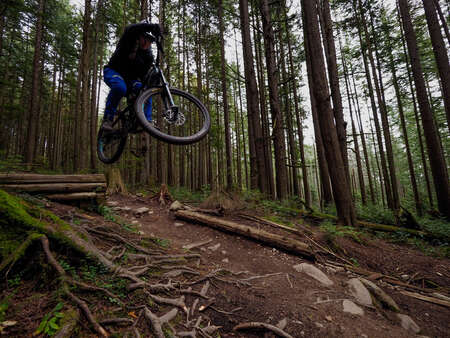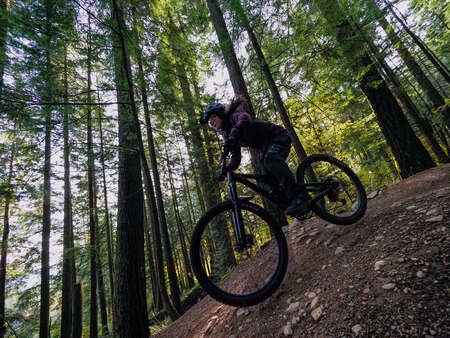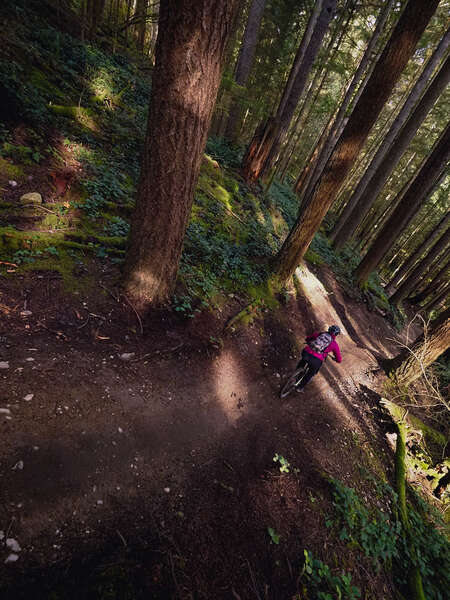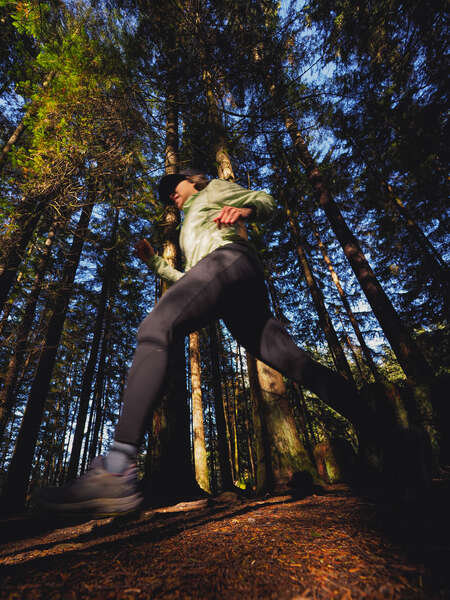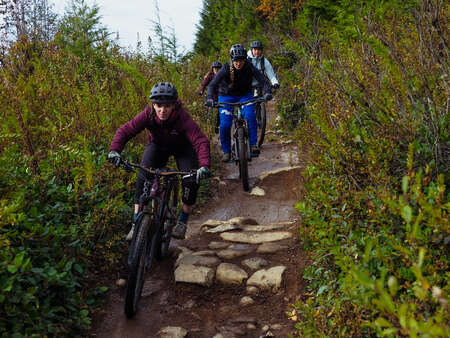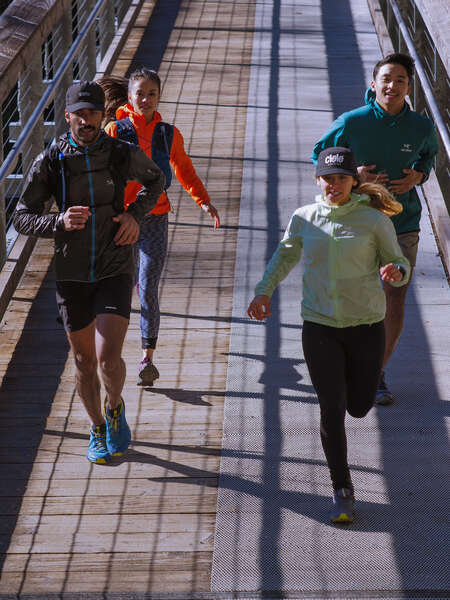We’re finally here, the third and final blog post to go along with our completed photo projects! The last three months have gone by incredibly quickly and I’m so happy to be able to share my work with everyone.
Since my last update I’ve only done one photoshoot going snowshoeing with a couple of friends. The day started off clear and sunny but by the time we got to the mountain, a thick fog rolled in ruining our chance for good views. Admittedly I was disappointed and unsure of what to do as I was counting on sunshine and a view for this shoot, but my friends kept spirits high and we managed to create shots along the way. Instead of focusing on landscapes and action shots (there’s not too much action in snowshoeing anyways), we focused on making it a more personal portrait-oriented shoot as the fog and snowfall provided great conditions for portraits. I primarily used the 40-150mm F2.8 PRO lens which I’m really loving as its wide range of focal lengths has proven incredibly versatile for action, portrait, and of course wildlife. Even as the snow started to fall heavily, the combination of the E-M1 Mark III and 40-150mm F2.8 PRO lens found focus quickly and accurately, making sure I didn’t miss any shots.
I’ve also gone out for solo missions on nearby trails and on drives for landscape and environmental shots. After another suggestion from my mentor Justin Kauffman, I’ve been able to use the 12-40mm F2.8 PRO almost as a macro lens with its super close focusing distance. I’ve had great results with it getting shots of foliage, frost, snow, and even a spider. I haven’t tried focus stacking yet and regret it a little bit for some of these shots – it’s definitely something I’d like to try out in the future. Ultimately these landscape and texture photos have helped better round out my project, offering variety outside of action and portrait shots.
I’ve learned a lot during this program while shooting in the field and from Justin during our calls. I learned to properly position myself while shooting my models depending on which lens I was using. At first it was a lot of trial and error but now I’m much better at knowing where I should stand when lining up a shot. This came about more quickly when Justin noticed I mostly used the 7-14mm F2.8 PRO lens for the bouldering shoot. He reminded me that using different lenses will ensure that my final images don’t all look the same and it will force me to look at shots from different angles.
Another lesson I received from Justin is to consider the whole end product, to be more deliberate in my planning and setting up my shot. He had noticed my shoots were mostly in the forest and suggested that I find some other locations to break up all the green. Luckily the local mountains were hit with early season snow to provide me with a different backdrop. Though these may be simple things for other photographers, they were valuable lessons for me as aspects I never had to consider in my typical photography.
It was difficult narrowing down my selection to only 30-40 photos for the final project and 10-15 photos for this blog post. My initial selection of images was well over 100 and it took the better part of a week for me to decide on this current group. It felt like something is missing having to narrow down so many photos to so few, but I also didn’t want to bore you and make everyone scroll through a couple hundred photos (though I’d be happy to show you all the outtakes).
After showing some of the photos I’ve taken to friends and family, the feedback I’ve gotten has helped me believe I can take good photos instead of thinking they were flukes or that people were just being nice. Thanks to this program I’ve gained a lot of confidence in my photography and hope I can continue learning and working on my craft. After this project I’d like to continue shooting sports, especially skiing/snowboarding during the winter and hiking/running in the summer. I’ve also been super inspired by the other participants and would like to try my hand at other styles of photography like macro, street, and night/astro. It would also be an interesting challenge to learn how to use lighting and try product and fashion photography too. In the future I’d love to print out my photos and have a website to show off my photography.
Overall, I feel confident in my project – it’s not exactly what I had in mind when I applied to the Break Free Program but it’s a solid body of work which I’m very happy with. My initial idea was grander in scale with larger dramatic landscapes but I quickly realized that wasn’t going to happen with zero budget, time limitations, and only being able to meet up and shoot with people for a few hours at a time and in nearby locations. At the same time, I feel that using more accessible locations in my photos will be more encouraging for people just getting into these sports, rather than using intimidating spots that seem totally unachievable to a beginner.
Another way my project strayed from the original idea is that I’d hoped for more diversity in adventurers, but I quickly realized that my own circles aren’t as diverse as I thought they were - or as they should be.
Notably lacking is Black and Indigenous representation which, if anything, further illustrates this issue within the outdoor community. How - as a POC that works in the outdoor industry - am I unable to find at least one or two Black and Indigenous friends/models to work with me for this project? I certainly didn’t ask for much help, but it shouldn’t have required a large circle of friends, a significant reach, or high number of followers to accomplish this. What I forgot in the flurry of photoshoots and excitement of new photo gear is that not everyone has equal access to the outdoors, whether because of financial or social reasons or otherwise. Not everyone has the means to gear up and get to the trailhead. Not everyone that makes it to the mountain is made to feel comfortable and welcome there. I had taken my privilege for granted and forgotten how long it takes to get the proper gear and knowledge to get into these sports, only to feel like you don’t belong out on the trail or on the mountain. This disappointing realization reminded me why I wanted to participate in this program and why I proposed this project in the first place: I want to help normalize the presence of POC in the outdoors.
Though I wasn’t able to work with any Indigenous or Black adventurers, I do still feel like I was able to contribute to the conversation of diversity in the outdoors in my own small way through this project. If my photos help encourage other POC to get outside, then I would consider it successful.
My work in this space is far from done and I’d like to continue doing photoshoots with friends and eventually working with others in the outdoor community here in Vancouver once it’s safe to do so. I’ve seen significant momentum this year with various groups representing and getting POC outdoors and it’s immensely encouraging to watch their progress. I’ve seen brands and photographers be more mindful about their model selection too, and all of this is a big step in the right direction. I hope one day that these outdoor sports and spaces will be welcoming for everyone and that we won’t need to so consciously push for diversity, and that it will simply be the norm.
Thank you, Olympus, for this incredible opportunity to participate in the Break Free Program. It has been a wonderful 3 months and I’m grateful to be placed among such a talented group of photographers – it’s been such a joy watching everyone’s progress along the way. This program has enabled us to be creative, to learn, and to push ourselves as photographers and I hope you continue this program for years to come, for the betterment of the art of photography. Thank you for giving me this platform and for being unafraid in supporting me with my project pushing for diversity in the outdoors. I hope other companies follow suit and find more ways to elevate POC. This experience has also helped me believe in myself and my work and will hopefully lead me to other opportunities. Also, a huge shout out to Justin and Amanda, thank you for all your help and guidance along the way.
Thank you to my friends, family, and partner who all believed I was going to be accepted into the program when I didn’t and for showing all the love and support throughout the process. Your confidence in me helped to keep me motivated.
Finally, I want to thank my friends and models for their enthusiasm, help, and patience: Vanessa, Dennis, Jae, Steph, Ben, Dan, Erika, Robynne, Maggie, Bella, Indra, and Chino. Your belief and support in my project mean so much to me and made me better understand the purpose and impact of the project. I didn’t expect to have so many people wanting to help me out and you all did so with no hesitation and with smiles on your faces the whole time. There were so many other people who wanted to help or model and I’m sorry I didn’t get to work with everyone! I don’t think I would’ve been able to coordinate any more photo shoots in the given time, but I’d love to get out there with you all in the new year.
Thanks for reading all of that if you’ve made it this far! I hope everyone has a Merry Christmas and happy holidays, and that you all stay healthy and happy. If you feel like it, please follow my photo endeavors on Instagram at @joshalmazar – thanks and bye for now!
